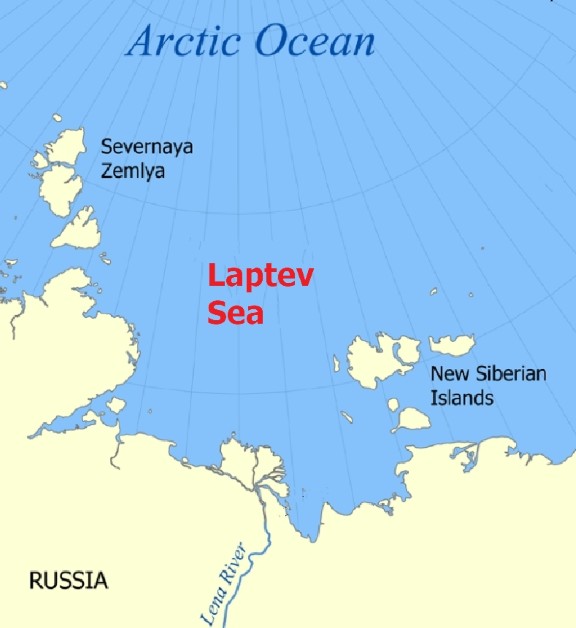Fauna of the Laptev Sea
 It is a marginal sea of the Arctic Ocean located off the northeastern coast of Asia. It is bordered by the Severnaya Zemlya archipelago, the Taimyr Peninsula, the Siberian coast, and the Novosibirsk Islands. It is connected to the Kara Sea to the west and the East Siberian Sea to the east via straits. The sea covers an area of 662 thousand km² and has a volume of 353 thousand km³. Its greatest depth is 3,385 meters (79°35′ N, 124°40′ E). The sea's strongly indented shores form many bays, coves, and peninsulas. Its waters are also home to many large and small islands. Many small rivers and several large ones flow into the sea, significantly impacting the hydrological regime of this shallow body of water.
It is a marginal sea of the Arctic Ocean located off the northeastern coast of Asia. It is bordered by the Severnaya Zemlya archipelago, the Taimyr Peninsula, the Siberian coast, and the Novosibirsk Islands. It is connected to the Kara Sea to the west and the East Siberian Sea to the east via straits. The sea covers an area of 662 thousand km² and has a volume of 353 thousand km³. Its greatest depth is 3,385 meters (79°35′ N, 124°40′ E). The sea's strongly indented shores form many bays, coves, and peninsulas. Its waters are also home to many large and small islands. Many small rivers and several large ones flow into the sea, significantly impacting the hydrological regime of this shallow body of water.
The climate is Arctic maritime, with signs of a continental climate in the southern coastal areas. Its high latitude, proximity to the mainland, and isolation from the Atlantic and Pacific Oceans determine the severity of the climate. The polar night lasts from three to five months. In winter, south and southwest winds prevail at speeds of 8-10 m/s. The air is strongly chilled, and the temperature drops to -34 °C in January. The absolute minimum was -61 °C. In summer, northerly winds (3-4 m/s) prevail, and temperatures range from 0 °C at the northern borders to 4 °C at the southern coasts in July. In small, well-protected bays, the air temperature can reach 12-15 °C in summer, with maximum temperatures of 22-24 °C and minimum temperatures of -4 °C.
Flora and Fauna of the Laptev Sea
The flora and fauna in these areas are scarce due to the harsh climate. The sea's vegetation is mainly Diatoms, of which there are more than 100 species. There are about 10 species of green algae, blue-green algae, and flagellates. Phytoplankton are characteristic of brackish waters, with a total concentration of approximately 0.2 mg/L. There are approximately 30 species of zooplankton, concentrated at about 0.467 mg/L. A nature reserve has been established in the Lena River delta. The reserve is home to 32 species of fish and 33 species of mammals.
Fish in the Laptev Sea
There are 39 species of fish in the sea, most of which are typical of brackish habitats. The most notable species are the least cisco (Coregonus sardinella), the rainbow smelt (Osmerus mordax), the saffron cod (Eleginus gracilis), the polar cod (Boreogadus saida), the Arctic flounder (Liopsetta glacialis), the Arctic char (Salvelinus alpinus), and the nelma (Stenodus nelma). Fishing in the Laptev Sea is relatively small-scale and concentrated primarily in river deltas. Common commercial fish species in the area include rainbow sardines (Dussumieria acuta), Arctic ciscos (Coregonus autumnalis), Bering ciscos (Coregonus lavaretus), broad whitefish (Coregonus nasus), and muksun (Coregonus muksun).
Mammals of the Laptev Sea
The following permanent mammal species inhabit the sea: ringed seal (Phoca hispida), bearded seal (Erignathus barbatus), harp seal (Pagophilus groenlandicus), and walrus (Odobenus rosmarus). The walruses of the Laptev Sea are sometimes identified as a separate subspecies, Odobenus rosmarus laptevi. The beluga whale (Delphinapterus leucas) visits this region seasonally. Only local residents hunt marine mammals. Walruses may only be hunted for scientific research or for subsistence by local tribes.
Zooplankton
Zooplankton is a set of animals inhabiting the marine and fresh water column, which are not able to ..

